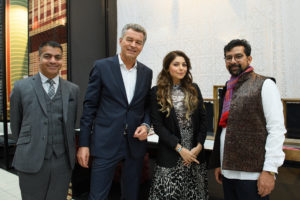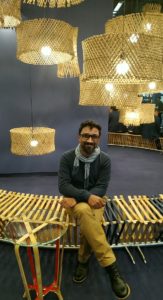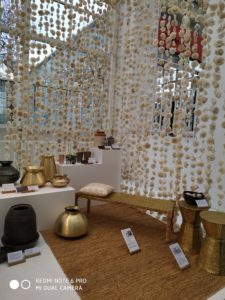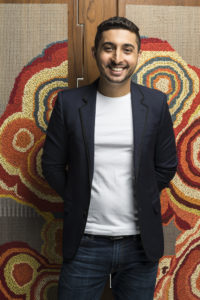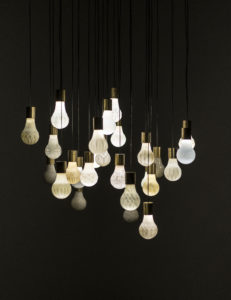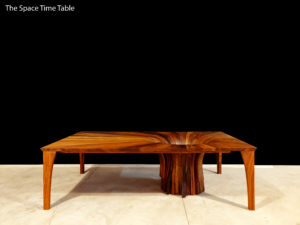Ambiente 2019 throws up a host of designer talent, including the Indian geniuses showcased at Ambiente 2019.
Nicolette Naumann
Photo credit: Dieter Schwer
At Messe Frankfurt’s Ambiente, they leave nothing to chance. Ever.
The well-oiled machinery it is, it begins prep for the next annual show two days after it finishes the current edition, reveals Nicolette Naumann, the livewire “boss lady”, as she dubs herself in jest.
While the magnitude and diversity of the world’s largest consumer trade fair is overwhelming for a first timer, Naumann has her finger on the pulse. Spread over Messe Frankfurt’s own sprawling space, which is akin to a township, she has mentally mapped the world’s biggest trade fair—be it the micro and macro trends, advising exhibitors on strategy, designers exhibiting on the way forward, seamlessly interacting with her expertly trained team, overseeing the many sub committee meets, officiating on behalf of Ambiente or sharing with media her insights on emerging trends in the consumer world. Naumann’s energy seems boundless.
As if this were not exhaustive enough, at the press briefing, she enthuses over the modern take on traditional hearty German winter foods on the supper menu, foods akin to those she grew up relishing, with as much gusto as she mustered while throwing open the mammoth fair earlier in the day. The interesting nuggets you glean from her—on how the unusual black radish is cooked in milk to wear off the sap and how the fish entree is a seasonal specialty, are a story in themselves. The perfect host she is, Naumann disarmingly shares how kitchen therapy is a means to unwind for her, how she stores away portions of the delicacies for really busy days.
Naumann has already moved on to working on the details of Messe Frankfurt’s next edition of Ambiente 2020, from February 7-11, with the baton back to the host country Germany. But looking back at Ambiente 2019, one of the biggest segment she introduced is to rope in India as a partner country.
India at Ambiente 2019
The highlight of Ambiente 2019 was India’s participation as a partner country. The brilliantly curated Hand Make in India saw Ayush Kasliwal, Design Director, AKFD and co-founder Anan Taya speaking a design language that relied on traditional handicrafts in a contemporary context. He emphasised, “The future belongs the artisans”, was the thread that seamlessly tied the India Pavilion together, reiterating that the message is just as important as the objects displayed.
Hand Make in India curated by Ayush Kasliwal (with red scarf) next to Kannika Kapoor.
Photo credit : Messe Frankfurt / Pietro Sutera
While Kasliwal’s installations such as Mudra at IGI airport in Delhi are talking points in India, his early exposure while working with design bigwigs such as Tom Dixon and Ashley Hicks brought into focus a more sustainable form of design.
Kasliwal used the Ambiente 2019 platform to highlight how sustainability is the backbone on which India’s tradition of handmade objects and innumerable crafts is nurtured. The mindfully curated handicrafts and artisanal stories at Ambiente 2019, from Jaipur rugs to Aarohana (a Pune-based venture where Warli tribals use the charkha to transform plastic into fabric), bore testimony that these crafts and art-based ventures are scalable in production, illustrating how several communities were absorbed into the timeless creation of highly desirable handcrafted objects.
Several Indian ventures and artisanal enterprises were part of Ambiente 2019.
Bamboo Guru Sundeep Sangaru
Sandeep Sanguru at Starry Nights cafe
Visitors at Ambiente were captivated by the sleek design of lanterns and winding seating at the installation ‘Starry Nights Café’ by Sandeep Sangaru of Sangaru Design Studio. Dubbed the ‘Guru of Bamboo’ for good reason, Sangaru’s understanding of the evergreen Bambusoideae (a lineage of perennial forest grasses), comprising more than 115 genera and 1400 species, was evident in his rendition inspired by rural life in India’s north-eastern states.
Not just a stunning visual, Sangaru’s avant-garde work is also functional. Multidisciplinary in the medium he uses, Sangaru’s search for techniques has led him to experiment with Persian wood carving from Kashmir, traditional lacquering from Bengaluru, where he is based, ceramics from Manipur, as well as hand-woven textiles and stonework. His attempt is to harmonise craft skills from diverse traditions with contemporary design, which was evident in his rendition of Starry Nights Cafe.
Sunil Sethi’s Stepwell and Karwan
Design Alliance’s Sunil Sethi demonstrated GI-specific curations at Stepwell and Karwan. He highlighted how century-old techniques were combined with contemporary aesthetics through his installation ‘Stepwell’, which are ancient sunken wells that were also carved beautifully as works of art. His presentation displayed products in an interactive environment that were innately modern in form, functional and relevant. Be it home decor or larger installations at public spaces or as a corporate statement, revival and reinventing of Indian crafts is the need of the hour.
Sunil Sethi’s curation showcases daily objects in Indian households in contemporary relevance
At Karwan, the journey of the caravan transported visitors through time to experience India’s aesthetic. Reminiscent of the early travels undertaken by traders, the light, airy atmosphere recreated on site is a modern take on how goods were transported and displayed in market tents.
ROOSHAD SHROFF
Rooshad Shroff
Among the talents that the Ambiente team scouts for year after year, 2019 showcased Indian architect and designer Rooshad Shroff. Epitomising the modern resurgence of craft, his C series of furniture, particularly the ones with knotted embroidery and inlay work, were one of a kind. They brought to fore his forte in integrating design elements. The much-acclaimed young designer, armed with a degree in Architecture from Cornell and combined with his exposure to international stalwarts like Zaha Hadid in London & OMA/REX in New York, brings to the table virtuosity in approach.
Chiselled Bulbs by Rooshad Shroff
His take on elements like the one-piece chiselled bulbs, each reflecting patterned luminous effect brought him accolades both in India and globally. The bottom-line was Shroff’s persistence in technique and research which yielded slick perfection.
Solid Bench
Besides the reiteration of sustainability, the refrain that design atelier Solid Bench delivered was their homage to nature. Every piece was a work of art. Each grain had a narrative that had been studied in depth to bring forth Haiku in wood, be it their Swan Bench or a mirror that was framed for eternity. Solid Bench uses Indian species such as Saal, East Indian Rosewood, North Indian Rosewood and Red Indian Cedar.
The Space Time Table
Solid Bench takes its outcomes very seriously, be it researching a tree for years or the fine joinery which results in superlative furniture. The Space Table with an intriguing hollow looks like a piece of piece of fluid wood furniture and was designed for Ambiente 2019.
Pato
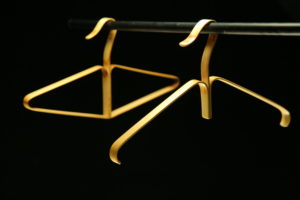
Bamboo Hanger
Picture your swish suit hanging on Pravinsinh Solanki’s one-piece hangers made in green gold coloured bamboo. The simple elegance of Pato or bird collection by Solanki, who is a faculty member at NID, is sheer design sophistication. What drove home the dire need to preserve and promote the rich Indian heritage was his work stint in Italy. Further, his tryst with sustainable crafts grew on a visit to Dimapur, in Northeast India, exposed him to the multifaceted use of bamboo and there was no looking back. The hangers, cut at a slant to reveal an oval belly and display Solanki’s finish, elevates it to a classy object that you would want to show off.
The Themes at Ambiente 2019
Ambiente identified three themes: Tasteful Residence, Quiet Surroundings and Joy-filled ambience. In the midst of the flurry of activity was MADE51’s (backed by the United Nations Refugee Agency (UNHCR) beautiful crafts made by refugee artisans from across the world. These included trinkets and enamelled utilitarian objects, as well as handcrafted treasures that reinforce the concept of sustainability.
Ambiente was the destination for designers looking to endorse their skills and concepts in unique high quality outcomes. Panta Rhei, a project by product designer Jihye Kang from Berlin, dwelled on sensory experiential. For the space conscious was Lotto Schloer’s ‘Fitted Space’, a bowl series with both sides cut to derive more out of the rounding, inspired by traditional Japanese Futamono (the serving of a robust stew or soup as part of a mid-day meal in a bowl). For her ‘betotherm’ tableware series she combined porcelain and concrete that helped preserve food temperature.
The ‘Univessels’ tableware by Maria Braun was induction compatible, which means you can cook and serve in this slick collection. Messe Frankfurt had it all—from Professor Charles Spence, a gastrophysicist from Oxford talking about the interactions of our senses while we are dining, or dealing with daily needs such as organising solutions like stackable options or multiuser utensils, or Marie Kondo’s decluttering revolution ‘Kon Mari’ to optimise the use of space, or the Point of Experience where you try out innovations firsthand, or the I-nose, an almost invisible antibacterial filter, the possibilities it threw up were infinite.
Each of the 12 massive halls simultaneously had ongoing seminars and demonstrations, allowing visitors and exhibitors to collaborate and exchange ideas on all aspects of dining, living and giving. The organisation takes its role in nurturing talent as its payback to the industry.


